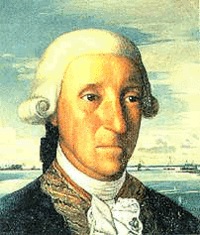Buenechea
Buenechea is the Spanish spelling of a Basque surname which also occurs in the variants Bonechea, Buonechea, Boenechea and Bonachea. The modern Basque spellings are Buenetxea and Bonetxea.[1] This surname is not common; Buenecheas and Buenetxeas between them number fewer than 100 in the whole of Spain, for the most part located in Gipuzkoa, where diocesan records indicate only around 1000 persons have been born with this name and its variants in the 300-year period 1600–1900. It is made up of the elements "buen, bon" (corruptions of "güen < goen < goien", 'upper') + "etxea" ('house').[2] The name therefore is originally related to "Goyenetch(e)", "Goyenech(e)" and "Go(i)enetxe".
Arms
All indigenous Basques are in theory armigerous. One family has the following blazon: Urdin eta zilar koloreko uhinen gainean, izurdea. Gorri bizizko hegala, eta bertan urrezko zortzi panela. i.e. Wavy azure and argent, a dolphin spiny, bordure gules eight water-lily leaves or.
Notable people

- A Domingo de Bonechea proved his status of Hidalgo before the Justices at Zarauz in 1738. It is unclear if this was the same person as the explorer (see below). A Juan Ignacio de Bonechea proved his status of Hidalgo before the Justices of Aya (Guipuzcoa) in 1772.
- Domingo de Bonechea, an 18th-century explorer, mentioned by Georg Forster in his account Voyage Around the World as "Domingo Buenechea".
- Manuel de Agote y Bonechea (1775–1803) from Getaria who kept a diary of his travels with the Spanish Royal Philippines Company.
- Francisco Bonechea, appointed Frigate Captain in 1774[3]
- Manuel de Buenechea, pilot of the doomed ship Oriflama
- José Ramón Leocadio Bonachea y Hernández (1845–1885) Cuban revolutionary general, executed by firing squad.
- Juan Antonio de Bonachea, captain in the Spanish Navy serving in Peru who investigated the disappearance of the Oriflama
- Vicente de Bonechea, (later spelled Buenechea) (1810–1884), an entrepreneur from Zarautz who came to San Sebastian as a cooper in the 1830s. He provided immense vats for storing wine to be sent to Espartero in exile in London in the 1840s. Known as "Vicente Txiki," he also had a salting business at the corner of ca. San Martin and ca. Urbieta in San Sebastian whose barrels were used as the drums for the first Tamborradas in the 1850s. His son
- Pedro Buenechea, Pedro ("Perico Chipiron") (1853–1932) was a judge and property owner who acquired buildings in Aldamar, San Sebastian, and businesses in the nearby old quarter, which still survive as Buenechea y Hernando.
- Ramon Buenechea (born 1851), also a son of Vicente Txiki, inherited the salting and barrelling business. In 1888 the factory in San Martin was compulsorily purchased by order of the ayuntamiento and he moved the business to a building known as Mira-Amara in the Amara district of San Sebastian. By 1894 he was employing up to 100 people, manufacturing 3000-4000 barrels ("cuarterolas") annually and exporting 1500 barrels of salt fish (besugo, papardo, perlón and tuna) to the interior per year. His only child died young, but he did not leave the business to his brother Pedro, in consequence of which Pedro was found in the Aero Club (San Sebastian) wearing a red tie on the day of the funeral, explaining that he thought he had had a brother but had been mistaken.
- Miguel Bonachea (born Santa Clara, Cuba 1960), Cuban guitarist and professor.
References
- ↑ "Deiturak - Euskaltzaindia". Euskaltzaindia. Retrieved 11 November 2011.
- ↑ Michelena, Luis (1997). Apellidos Vascos. Donostia: Editorial Txertoa. pp. 87, 96. ISBN 84-7148-008-5.
- ↑ Estudios genealógicos, heráldicos y nobiliarios en honor de Vicente de Cadenas y Vicent, 1978